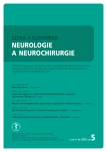Tumefactive Variant of Multiple Sclerosis – Two Case Reports
Authors:
I. Okáčová 1,2; Y. Benešová 1; E. Vlčková 1,2; M. Keřkovský 2,3; P. Praksová 1,2; M. Hladíková 1,2; J. Kosík 4; D. Uldrijanová 1; P. Štourač 1,2; J. Bednařík 1,2
Authors‘ workplace:
Neurologická klinika LF MU a FN Brno
1; CEITEC – Středoevropský technologický institut, MU, Brno
2; Radiologická klinika LF MU a FN Brno
3; Neurochirurgické oddělení, Nemocnice Na Homolce, Praha
4
Published in:
Cesk Slov Neurol N 2013; 76/109(5): 641-647
Category:
Case Report
Overview
Diagnosis of multiple sclerosis (MS) according to the revised diagnostic criteria is based on clinical symptoms and magnetic resonance imaging (MRI). Diagnosis of MS requires elimination of more likely diagnoses. Multiple sclerosis lesions are visible on MRI as T2 hypersignal lesions typically in at least two of the four CNS areas: periventricular, juxtacortical, infratentorial and spinal cord. Tumefactive MS (TMS) is a rare variant of this disease with the estimated prevalence of about 3 cases per million people. Its radiological and clinical symptoms are different from common MS variants and could mimic other diseases, such as brain tumours and inflammatory diseases. Typical radiographic feature of TMS is defined as a solitary large lesion sized >2 cm, associated with perilesional oedema and/or the presence of ring enhancement on MR. Clinical signs and symptoms depend on lesion location and size and include headache, cognitive abnormalities, mental confusion, aphasia, apraxia and/or seizures. Since differential diagnosis of such clinical presentation and MRI is difficult, brain biopsy is often required. Diagnosis could be supported by positron emission tomography, cerebrospinal fluid examination and evoked potentials. In this report, we present two patients with tumefactive MS. The purpose of the report is to emphasize clinical and radiological features of this rare disease and to pinpoint examination procedures that could be used in differential diagnosis.
Key words:
tumefactive multiple sclerosis – magnetic resonance imaging – positron emission tomography – stereotactic brain biopsy
The authors declare they have no potential conflicts of interest concerning drugs, products, or services used in the study.
The Editorial Board declares that the manuscript met the ICMJE “uniform requirements” for biomedical papers.
Sources
1. Paty DW, Oger JJ, Kastrukoff LF, Hashimoto SA, Hooge JP, Eisen AA et al. MRI in the diagnosis of MS: a prospective study with comparison of clinical evaluation, evoked potentials, oligoclonal banding, and CT. Neurology 1988; 38(2): 180– 185.
2. Barkhof F, Rocca M, Francis G, Van Waesberghe JH, Uitdehaag BM, Hommes OR et al. Validation of diagnostic magnetic resonance imaging criteria for multiple sclerosis and response to interferon beta1a. Ann Neurol 2003; 53(6): 718– 724.
3. Lucchinetti CF, Gavrilova RH, Metz I, Parisi JE, Scheithauer BW, Weigand S et al. Clinical and radiographic spectrum of pathologically confirmed tumefactive multiple sclerosis. Brain 2008; 131(Pt 7): 1759– 1775.
4. Kepes JJ. Large focal tumor‑like demyelinating lesions of the brain: intermediate entity between multiple sclerosis and acute disseminated encephalomyelitis: a study of 31 patients. Ann Neurol 1993; 33(1): 18– 27.
5. Dagher AP, Smirniotopoulos J. Tumefactive demyelinating lesions. Neuroradiology 1996; 38(6): 560– 565.
6. Schwartz K, Erickson BJ, Lucchinetti CF. Pattern of T2 hypointensity associated with ring enhancing brain lesions can help differentiate pathology. Neuroradiology 2006; 48(3): 143– 149.
7. Kiriyama T, Kataoka H, Taoka T, Tonomura Y, Terashima M, Morikawa M et al. Characteristic neuroimaging in patients with tumefactive demyelinating lesions exceeding 30 mm. J Neuroimaging 2011; 21(2): e69– e77.
8. Polman CH, Reingold SC, Banwell B, Clanet M, Cohen JA, Filippi M et al. Diagnostic criteria for multiple sclerosis: 2010 revisions to the McDonald criteria. Ann Neurol 2011; 69(2): 292– 302.
9. O’Connor AB, Schwid SR, Herrmann DN, Markman JD, Dworkin RH. Pain associated with multiple sclerosis: systematic review and proposed classification. Pain 2008; 137(1): 96– 111.
10. Tan HM, Chan LL, Chuah KL, Goh NS, Tang KK. Monophasic, solitary tumefactive demyelinating lesion: neuroimaging features and neuropathological diagnosis. Br J Radiol 2004; 77(914): 153– 156.
11. Kopal A, Mrklovský M, Ehler E. Akutní diseminovaná encefalomyelitida a její možná záměna s AIDP. Neurol Prax 2007; 8(6): 364– 366.
12. Boviatsis EJ, Kouyialis AT, Stranhjalis G, Korfias S,Sakas DE. CT‑ guided stereotactit biopsies of brain stem lesions: personal experience and literature review. Neurol Sci 2003; 24(3): 97– 102.
13. Villringer K, Jäger H, Dichgans M, Ziegler S, Poppinger J, Herz M et al. Differential diagnosis of CNS lesions in AIDS patients by FDG‑ PET. J Comput Assist Tomogr 1995; 19(4): 532– 536.
14. Olivero WC, Dulebohn SC, Lister JR. The use of PET in evaluating patients with primary brain tumours: is it useful? J Neurol Neurosurg Pychiatry 1995; 58(2): 250– 252.
15. Shields AF, Grierson JR, Dohmen BM, Machulla HJ,Stayanoff JC, Lawhorn‑ Crews JM et al. Imaging proliferation in vivo with [F‑ 18]FLT and positron emission tomography. Nat Med 1998; 4(11): 1334– 1336.
16. Bakshi R, Miletich RS, Kinkel PR, Emmet ML, Kinkel WR. High‑resolution fluordeoxyglucose positron emission tomography shows both global and regional cerebral hypometabolism in multiple sclerosis. J Neuroimaging 1998; 8(4): 228– 234.
17. Confavreux C, Vukusic S. Natural history of multiple sclerosis: implications for counselling and therapy. Curr Opin Neurol 2002; 15(3): 257– 266.
Labels
Paediatric neurology Neurosurgery NeurologyArticle was published in
Czech and Slovak Neurology and Neurosurgery

2013 Issue 5
- Memantine Eases Daily Life for Patients and Caregivers
- Metamizole vs. Tramadol in Postoperative Analgesia
- Metamizole at a Glance and in Practice – Effective Non-Opioid Analgesic for All Ages
- Memantine in Dementia Therapy – Current Findings and Possible Future Applications
- Advances in the Treatment of Myasthenia Gravis on the Horizon
Most read in this issue
- Wilson Disease
- Glioblastoma Multiforme – a Review of Pathogenesis, Biomarkers and Therapeutic Perspectives
- Tumefactive Variant of Multiple Sclerosis – Two Case Reports
- The 3F Test Dysarthric Profile – Normative Speach Values in Czech
